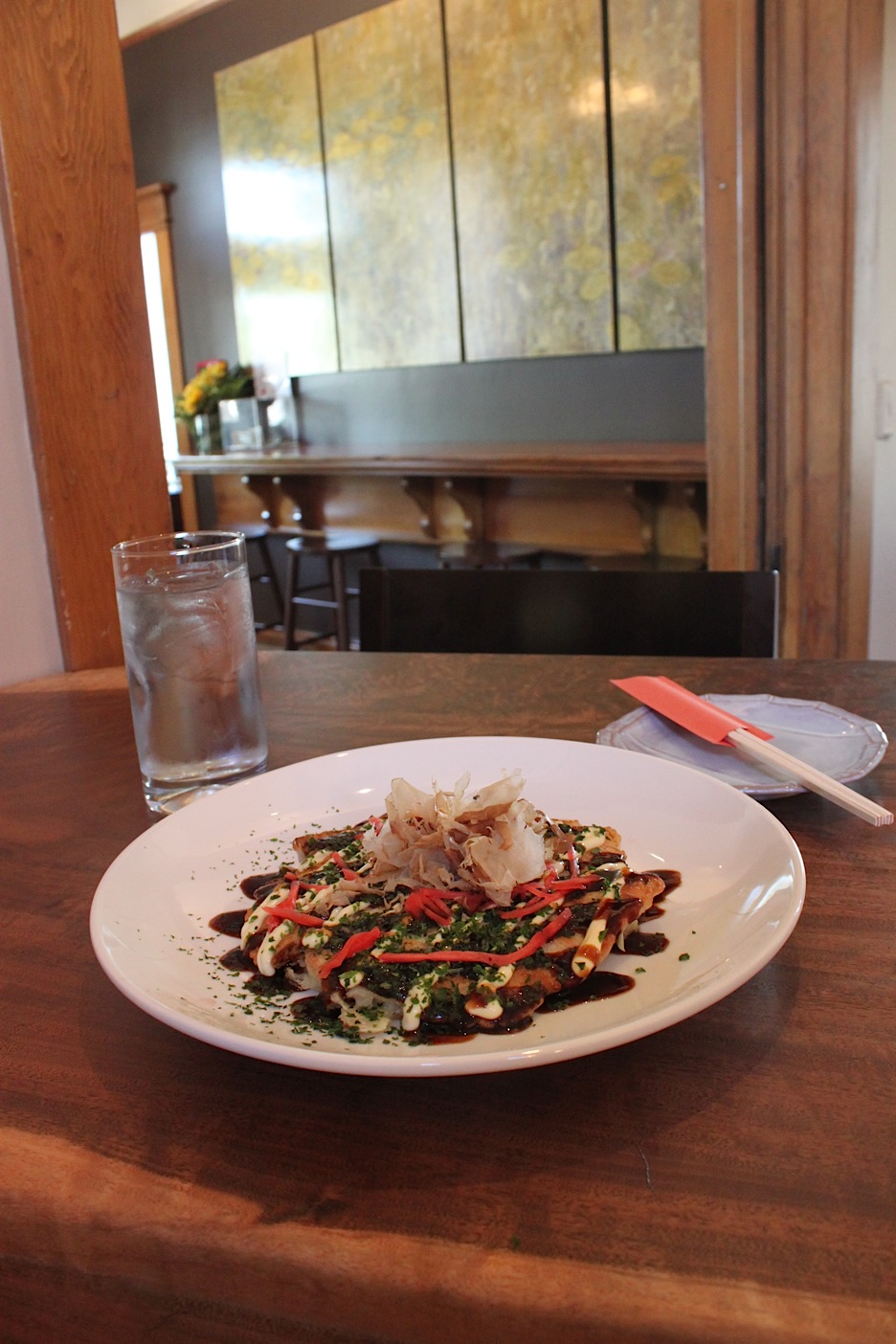MARIANI’SVirtual Gourmet
January 22,
2012
NEWSLETTER
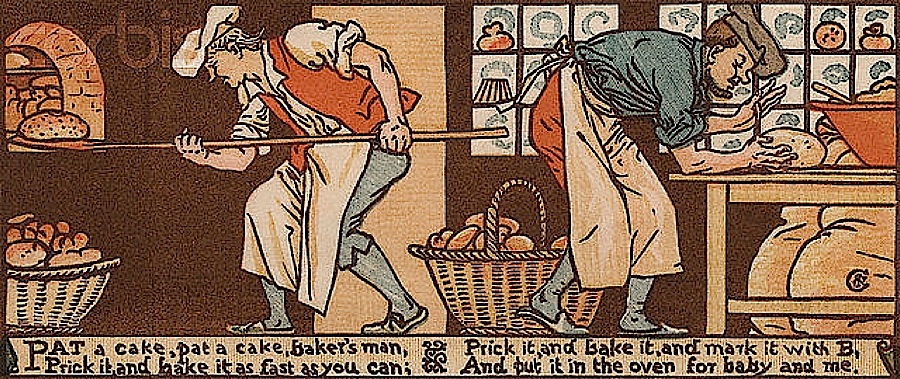
❖❖❖
THIS WEEK
by John Mariani
NEW YORK CORNER
Valbella Midtown
by John
Mariani
Cocktails Trump White Wine for Aperitifs
by John Mariani
❖❖❖
SAVORING ARIZONA
by John Mariani
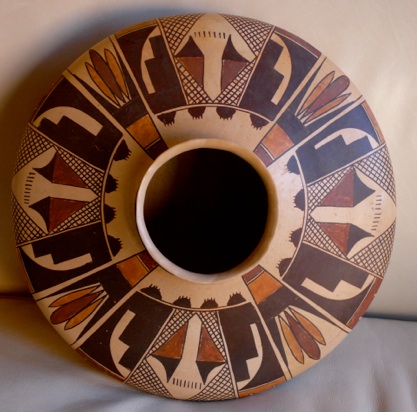
Phoenix and Scottsdale, with histories that date back 1200 years, are quite different cities, though given the way roads and Interstates are laid out in the Southwest, Scottsdale, with 220,000 people, seems like an extension of the larger city of one million. Phoenix is the business center of the region, but Scottsdale has a disproportionate number of the state's finest hotels and resorts, and many of the area's most exciting restaurants among what seems hundreds of national chains. Here are some new places in both cities, and one older with a new chef.
Spread
over six acres of desert and within sight of
Camelback Mountain, The Hermosa Inn incorporates
restored portions of the home and studio
of cowboy
artist Lon Megargee back in the 1930s, and the hotel’s
walls are hung with his superb paintings of the west,
cowboys, horses, Apaches, landscapes—a vast array of
Americana by a highly gifted and very successful
artist of his day.
The original Casa Hermosa
opened in 1936 and became the current Inn, with
upgrades in 1941, with various additions and
remodeling over the next few decades, most recently in
2009.There are 34 individually
decorated suites at the Inn, all done in the adobe
brick style and interiors all have fireplaces that
might come in handy this winter. Outside the patios
are carefully planted desert gardens along walkways
and small bridges that lead to the restaurant, called
Lon’s.
Lon’s is of course
very much in the style of all else here, and the main
building meanders like a household, with a beautiful
thousand-bottle wine cellar room (below) seating 12
guests at a trestle table, and spacious private rooms
for meetings and dinners. The 86-seat main dining room is
done (right)
with wood-beamed ceilings, a beehive fireplace,
Megargee’s artwork, and the Last Drop Bar is a good
place indeed to drop by to 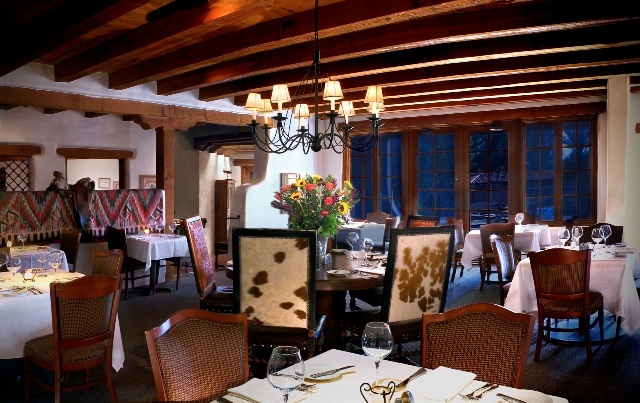 get out of the
Scottsdale sun, which in summer easily tilts well
above 100 degrees.
get out of the
Scottsdale sun, which in summer easily tilts well
above 100 degrees.
Chef Jeremy Pacheco
has come on as executive chef at Lon’s, after serving
as chef de cuisine at Society
Café in Las Vegas, as well as at
other Steve Wynn venues there, like SW Steakhouse.
Before that he had been in Phoenix at The Phoenician
and the Sheraton El Conquistador in Tucson, so his
ties to the American Southwest are deep and his
understanding of its bounty broad.
With four others, I sat down in the cool wine cellar
to an extensive tasting menu that began with ahi tuna
seared on a heated block of Himalayan green sea salt,
served with pickled onions, “ceviche” soy sauce. A delicious
gazpacho with bay scallops
and crab ceviche, laced with lime olive
oil followed, along with heirloom lettuce, roasted
local beets, crow’s dairy goat cheese vinaigrette.
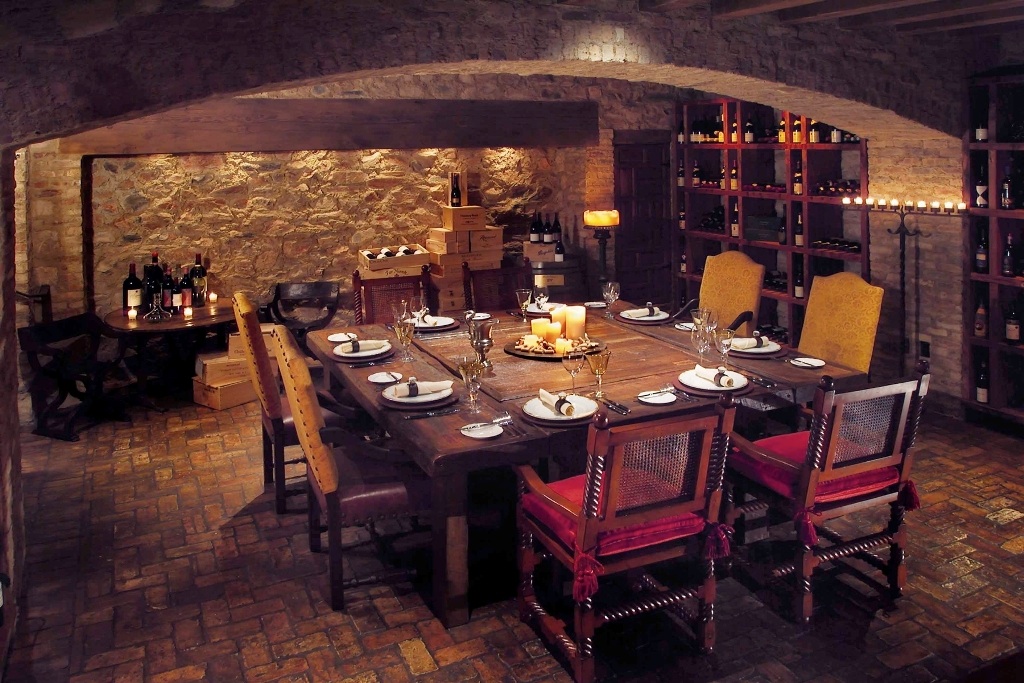 The fish
courses was succulent pan-roasted Pacific halibut wild
mushrooms, snap peas, cucumber salad, and
mushroom-fennel broth, and for the meat, a thick,
juicy Berkshire pork loin with crisp belly,
cheddar creamed corn, spicy broccoli, and grilled
organic peach—a terrifically tasty dish with all the
elements of the best contemporary cooking about it.
The fish
courses was succulent pan-roasted Pacific halibut wild
mushrooms, snap peas, cucumber salad, and
mushroom-fennel broth, and for the meat, a thick,
juicy Berkshire pork loin with crisp belly,
cheddar creamed corn, spicy broccoli, and grilled
organic peach—a terrifically tasty dish with all the
elements of the best contemporary cooking about it.
With these dishes we drank
mostly Arizona wines, then went on to desserts like
the “cowboy candy
bar” of salted caramel, spiced chocolate, marcona
almonds, and coco nib ice cream, which really was a
perfect paean to western tastes, along with a Mexican
“tira misu”
of Ibarra chocolate, mascarpone cream, Patron
café anglaise, and Kahlua ice cream. For a
summery dessert there was rhubarb and strawberry pie
and an upside down peach cobbler blackberry compote,
ginger ice cream.
This is not just the kind of food you’d hope to find
in the Southwest but a testament to the refinement you
will find in resorts where everything is very much
concentrated on a distinct style. Everything fits
together seamlessly, with real individuality, and,
unlike some resorts that feel contrived, the backdrop
of being the premises of a fine American artist, Lon Megargee, makes it all
the more indelible.
Lon’s is not overly
expensive, with entrees from
$22 to $34 for dinner. It’s also open for
breakfast and lunch and weekend brunch.
Citizen Public House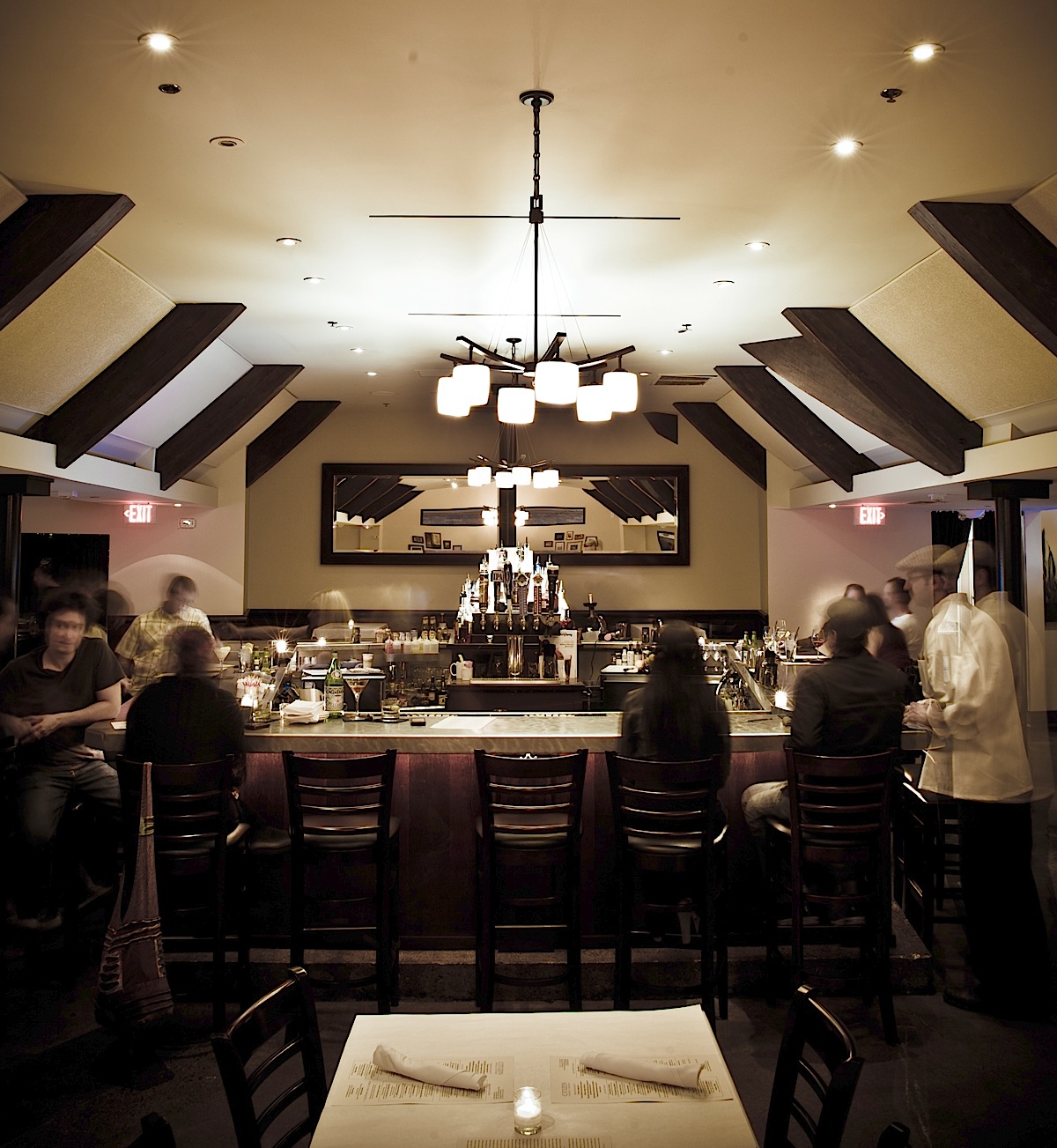
7111
East 5th Avenue
Scottsdale, AZ
480-398-4208
www.citizenpublichouse.com
A trio of very serious
professionals give Citizen Public House an edge that a
lot of similar casual restaurants in the
Phoenix/Scottsdale area just don’t achieve.
Owner/partner Andrew Fritz,
Chef/partner Bernie
Kantak and
Mixologist/partner Richie Moe
have have
thought through every detail in this new gastropub,
and with its cathedral
ceiling, big roomy leather booths, soft lighting, a
central bar and family photos, the welcome is warm,
the cocktails are impeccably made, and the menu is
very tough to choose from because just about
everything sounds so delicious. Add to that
plenty of beer on tap and a fine array of spirits and
you have a very contemporary American concept.
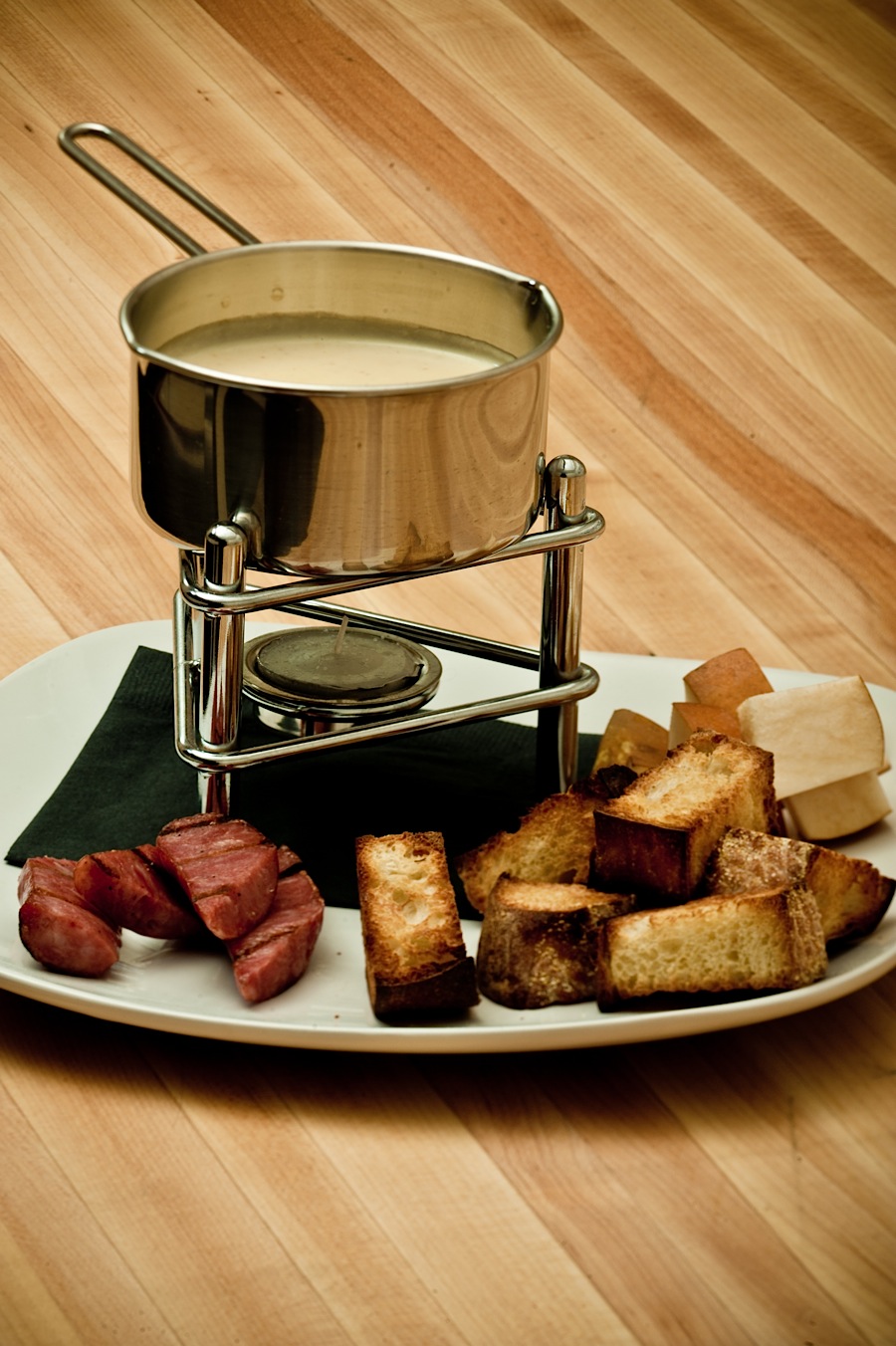 There
are a lot of snack items like rosemary roasted nuts
and—in what is the first of many bacon-inspired foods
here— bacon fat flavored popcorn, which is really,
really good. They also do a pork belly pastrami with
spaetzle and Brussels sprouts; grits and gumbo; and
“Bernie’s Mac ‘N Cheese—one of the best I’ve ever
tried not to
eat all of, a very difficult restraint on my part only
because my friends were digging in fast. There's even
a welcome take on a modern fondue (left)
that's fun and very convivial for the table.
There
are a lot of snack items like rosemary roasted nuts
and—in what is the first of many bacon-inspired foods
here— bacon fat flavored popcorn, which is really,
really good. They also do a pork belly pastrami with
spaetzle and Brussels sprouts; grits and gumbo; and
“Bernie’s Mac ‘N Cheese—one of the best I’ve ever
tried not to
eat all of, a very difficult restraint on my part only
because my friends were digging in fast. There's even
a welcome take on a modern fondue (left)
that's fun and very convivial for the table.
There’s a good lamb burger, and the grilled
chicken with corn risotto, smoked onions and rich
mushroom hash dashed with truffle oil will make you
smile broadly at every bite. Desserts, by Tracey Dempsey, run
to the scrumptious—a “black and tan” chocolate pot de
crème, caramel pudding, whipped cream, pretzel
brittle and brown sugar; bourbon-glazed donut bread
pudding; and marvelous chocolate pecan bars with
chicory streusel.
Citizen
Public House is open daily from 3 PM. Open 7 Days a
Week.
Beckett's Table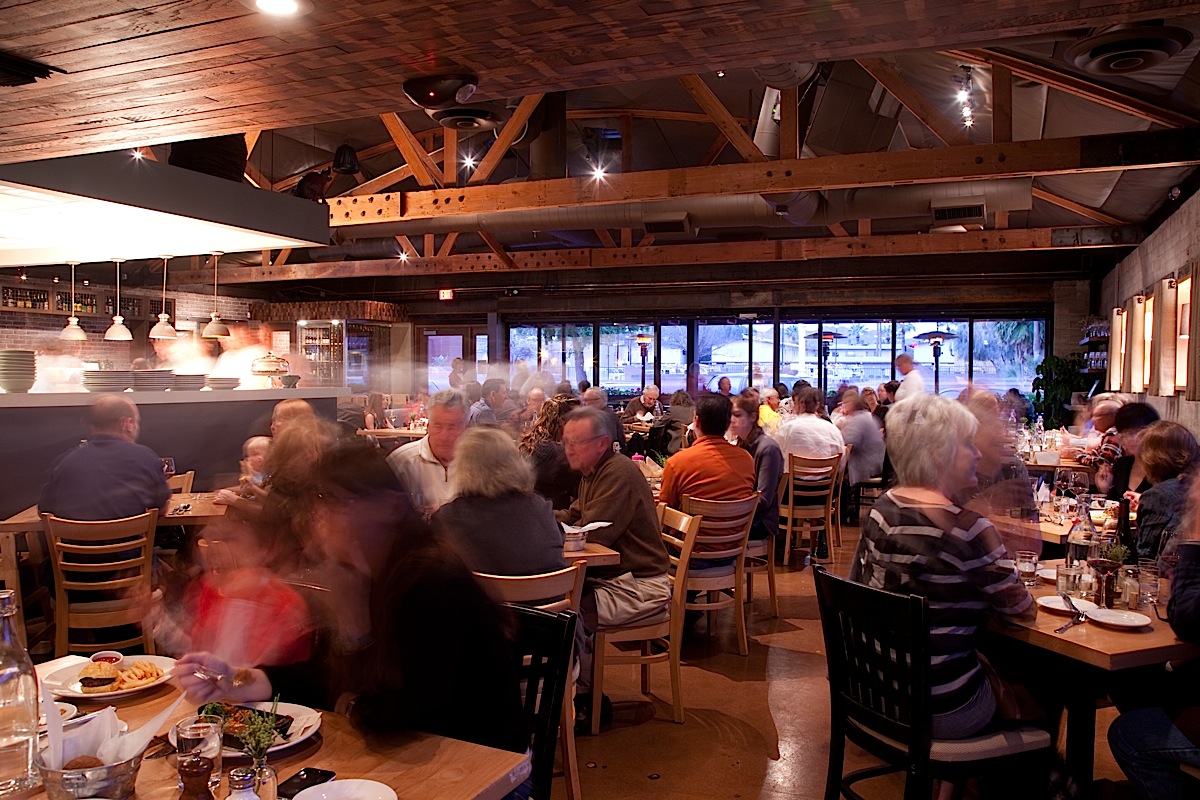
3717 East Indian School Road, Phoenix
602-341-3004
www.beckettstable.com
Not
radically different from Citizen in food style but
somewhat more predictable is Beckett’s Table, which
has the atmosphere of a handsome family eatery, where
Chef Justin Beckett serves a menu with something for
everyone on it.
Its location in an unattractive strip mall—not
unusual for a restaurant of substance out there—masks
a good-looking dining room with open kitchen, exposed
beams and concrete floor, kind of like the ultimate
rumpus room. The menu has appetizers, soups, mains,
sides, and on Wednesday, 3-course family dinners,
including wine, at 5:30 PM.
Of the starters I
tried I liked most the grilled cheese with pancetta,
four cheeses, and a bowl roasted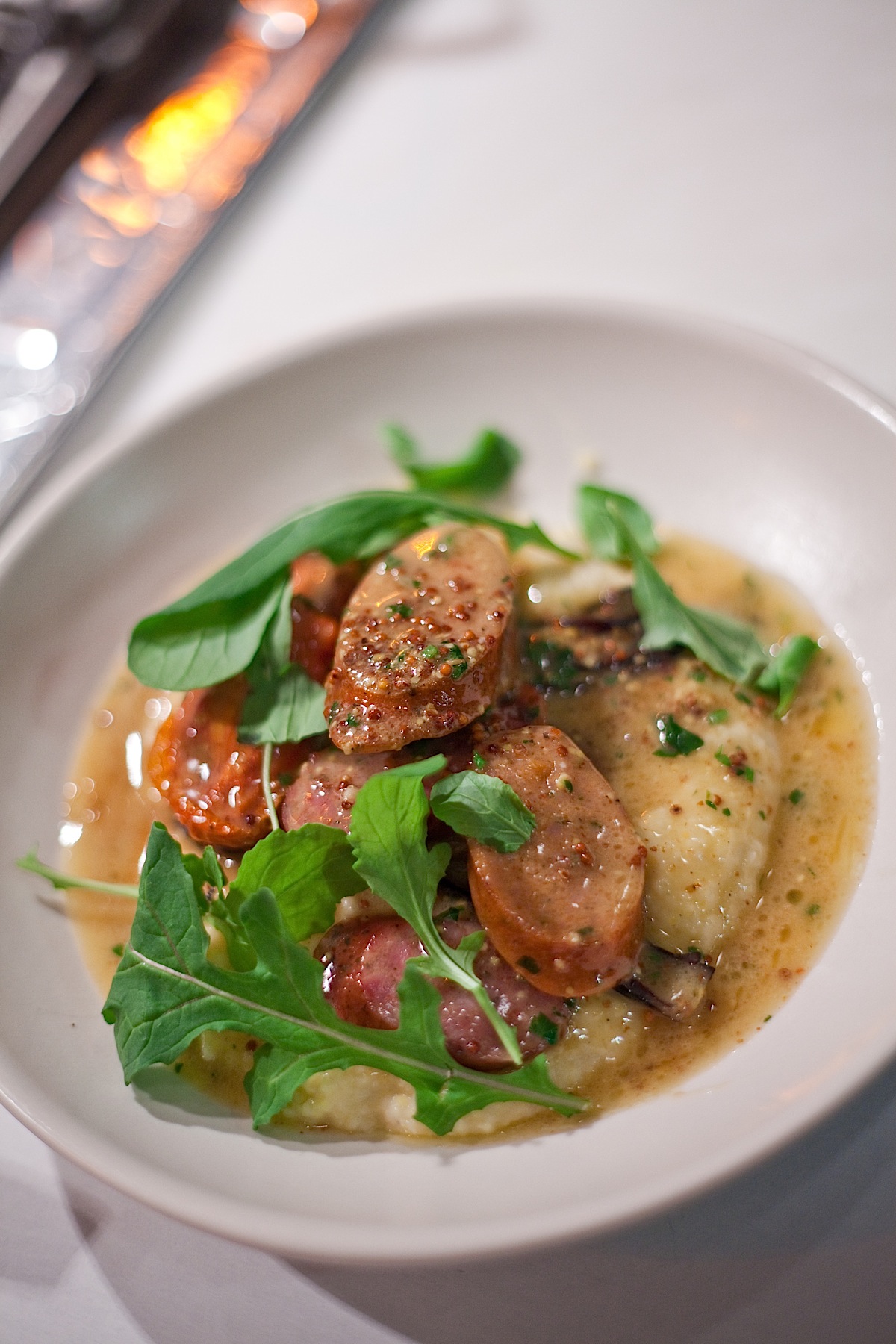 red pepper
tomato soup on the side, which just goes to prove that
old luncheonette favorites can be done with
considerable panache in the hands of a good chef. The
zucchini pancakes are also a good choice.
red pepper
tomato soup on the side, which just goes to prove that
old luncheonette favorites can be done with
considerable panache in the hands of a good chef. The
zucchini pancakes are also a good choice.
Among main courses, I recommend the
excellent, velvety pork osso buco confit with vegetable
spaetzle and a pepper reduction. Beckett has
a real knack with pork: it shows well in his green
chile pork stew, with cornbread and cotija cheese.
Grits and sausage (left)
will leave no one hungry for more--it's a hefty dish.
For dessert I liked the gooey fig
and pecan pie with cream cheese, but his -s’mores
dipped in chocolate are as wrongheaded as any dish
I’ve had in recent memory.
The wine list is a very solid one,
printed on one broadsheet, with an app laudable number
of Arizona and southwestern wines that includes a
terrific Pillsbury One Night Stand Sangiovese
Rosé from Tombstone.
Beckett’s
Table is open for dinner Tues.-Sun.; Appetizers run
$5-$10, mains $13-$19.
Nobuo
at Teeter House
622 East Adams Street, Phoenix
602-252-4682
Relocated
from
a cement block of a small eatery to a turn-of-the-century,
wood-floored bungalow, Nobuo Fukuda has been able to
deepen the already very broad izikaya-style
menu that won him justifiable high praise at SeaSaw,
which closed two years ago.
Fukuda (below) is very
much a local hero, especially in a region without many
sushi masters. Born and raised in Tokyo, he first made
his mark in Phoenix at the Asian fusion Restaurant
Hapa with chef-owner James McDevitt. After wowing
everybody at SeeSaw, which really was tiny, he now has
more space and time, so that in the daytime Teeter
House is a Japanese tea room with snacks and beer. In
the evening it turns into a restaurant with 8-course 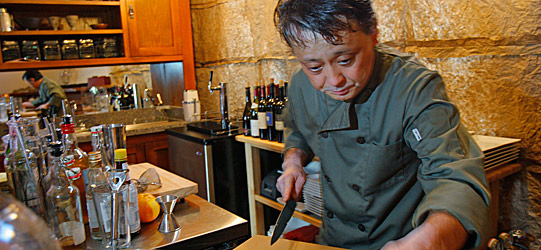 tasting meals on Friday and Saturday,
with 24 hours' notice.
As ever, Fukuda does almost all the prep and
cooking, working in front of you at the counter if you
like, which are the best seats in the house.
tasting meals on Friday and Saturday,
with 24 hours' notice.
As ever, Fukuda does almost all the prep and
cooking, working in front of you at the counter if you
like, which are the best seats in the house.
It is useless for me to tell you what I ate
when I visited some months ago, especially because the
change of seasons changes Fukuda’s ideas, which come
fast and furious as he works with whatever he
discovered that day to suit his fancy. I can
certainly vouch for the creativity and refinement, the
subtlety and the textural contrast of all the dishes
he prepared for me by slicing, saucing from an array
of tubes and bottles, and composing them with
little microgreens and touches of herbs. A tasting
meal will always include several varieties of sashimi,
followed by something like five spice braised oxtail,
and ending with an array of pastries. The whole deal
is only $40. (Otherwise you can order a la carte at
equally modest prices.)
The best thing is just to go, see what’s on the
menu and choose from what’s new and exciting. There will
always be plenty of both, crystallizing Fukuda’s
reputation as one of the best chefs in the west.
Open for
lunch and dinner daily.
❖❖❖
NEW YORK
CORNER
by
John Mariani
Photos by Deva Vu
Studios
Valbella
Midtown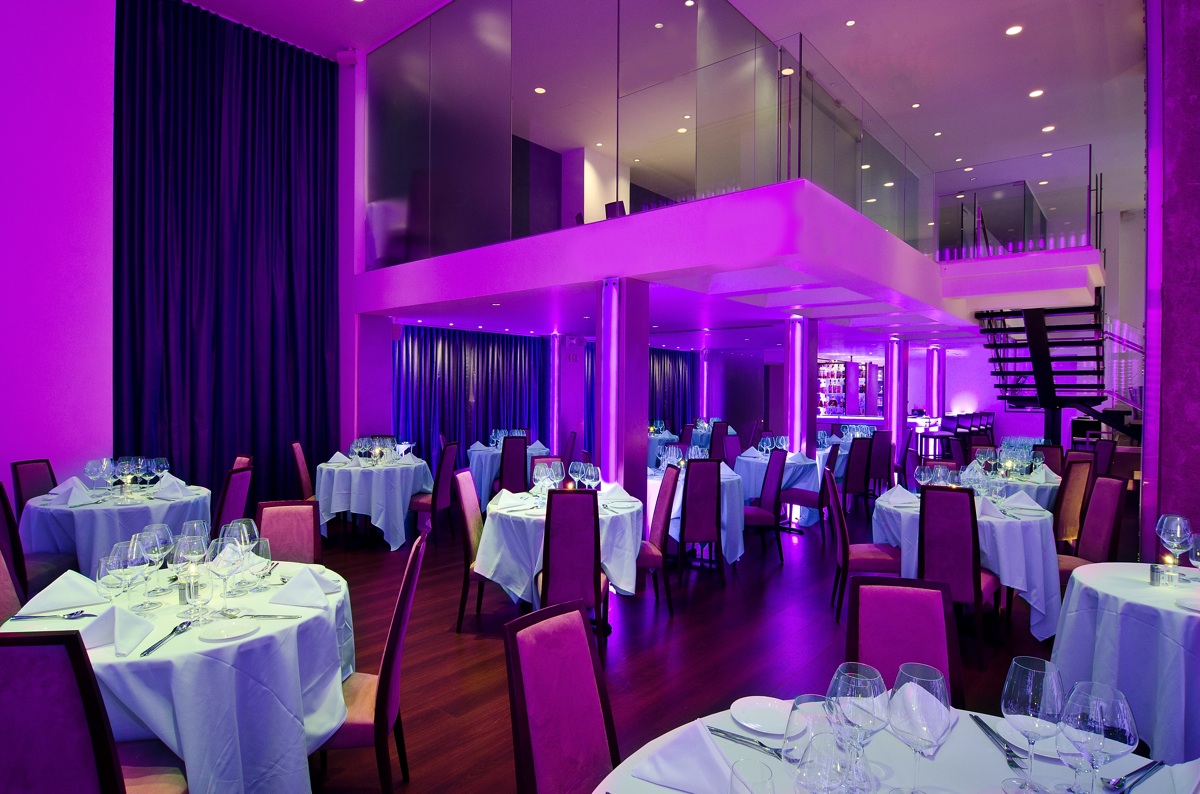
520 Madison Avenue (off 53rd Street)
212-888-8955
www.valbellamidtown.com
The success of a restaurant is more easily
counted in years than in branches, but now, with three
Valbellas in the region--in Greenwich, CT, the Meat
Market District of NYC, and the newest in midtown
Manhattan (and another similar restaurant named Tutta
Bella in Scarsdale, NY), owner David Ghatanfard has
achieved both distinctions. The original Greenwich
restaurant opened in 1992 and built upon a clientele
from the Gold Coast that came for first-rate, simply
prepared continental cuisine and an astounding wine
list of more than 1,400 selections. The Meat Market
unit is now almost seven years old and going very
strong in that location. The newest branch takes over
the former Alto space, once run by Scott Conant and
Chris Cannon, then by Mr. Cannon and Chef Michael
White, still a split last year made the business
apparently unviable.
But it is the rare piece of real
estate in Manhattan that goes vacant for very long,
and Mr. Ghatanfard has come to fill the bi-level space
with Valbella, which, like its namesakes, is
absolutely driven by its ingredients. I know
some of Mr. Ghatanfard's purveyors in the Bronx, and
they tell me that he purchases nothing but the
finest and what's best in the market that day.
Thus, if there are perfect Nantucket bay scallops,
Valbella will have them; Dover sole of the
unstinting quality? Valbella offers them as a
special; white truffles just in? The most fragrant
will be at Valbella. This may make for a high
tab at night's end, but you will get the very best,
and the price will probably not be quite as high as
elsewhere in Manhattan for inferior ingredients.
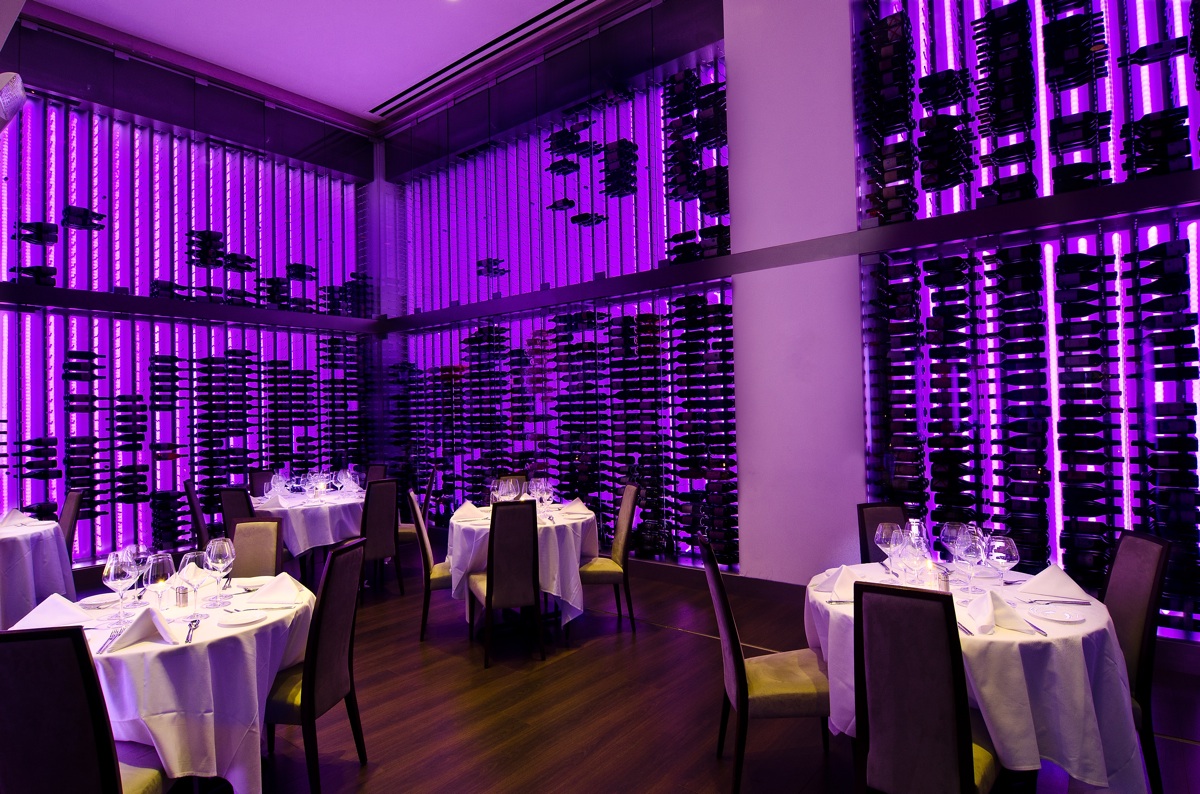 Mr. Ghatanfard
has taken the former premises, once rather broken up
in design and glowing with eerie blue light, and made
the space flow better in a minimalist design that at
the moment is bathed in a violet light, which is
surprisingly flattering to the complexion. Still, it
is an odd choice of color, one that might well be
modulated or changed in the future. To the left of the
main dining room (above)
is the smaller, impressive wine room (left), and
upstairs two private dining rooms (below) The
service staff needs some seasoning and at this point
can be a little to chummy.
Mr. Ghatanfard
has taken the former premises, once rather broken up
in design and glowing with eerie blue light, and made
the space flow better in a minimalist design that at
the moment is bathed in a violet light, which is
surprisingly flattering to the complexion. Still, it
is an odd choice of color, one that might well be
modulated or changed in the future. To the left of the
main dining room (above)
is the smaller, impressive wine room (left), and
upstairs two private dining rooms (below) The
service staff needs some seasoning and at this point
can be a little to chummy.
The menu, by Chef Joe Giordano, is pretty much a
duplicate of the 13th Street Valbella. Best way
to begin, then, is with a lavish platter of
shellfish--lobster, clams, mussels, oysters, and
shrimp--for the table, beautifully presented and
served with three dipping sauces. Otherwise you
will not be disappointed by the burrata with
prosciutto and greens or the carpaccio of beef with
arugula and shaved parmigiano.
Valbella does a fine job with its
nine pastas, including, at the moment, a very special
trenette with
black and white truffles in a cream sauce of daunting
richness. Fat paccheri
with garlic, oil and a roasted lamb
ragù, a hint of peperoncini and tomato is a fine and
hearty dish for winter, and spaghetti cacio e pepe is
toothsome but overwrought with a julienne of
vegetables and a blanketing cheese sauce. Risotto
Adriatico begins with Canaroli rice cooked tender and
served with langoustine and crabmeat in a 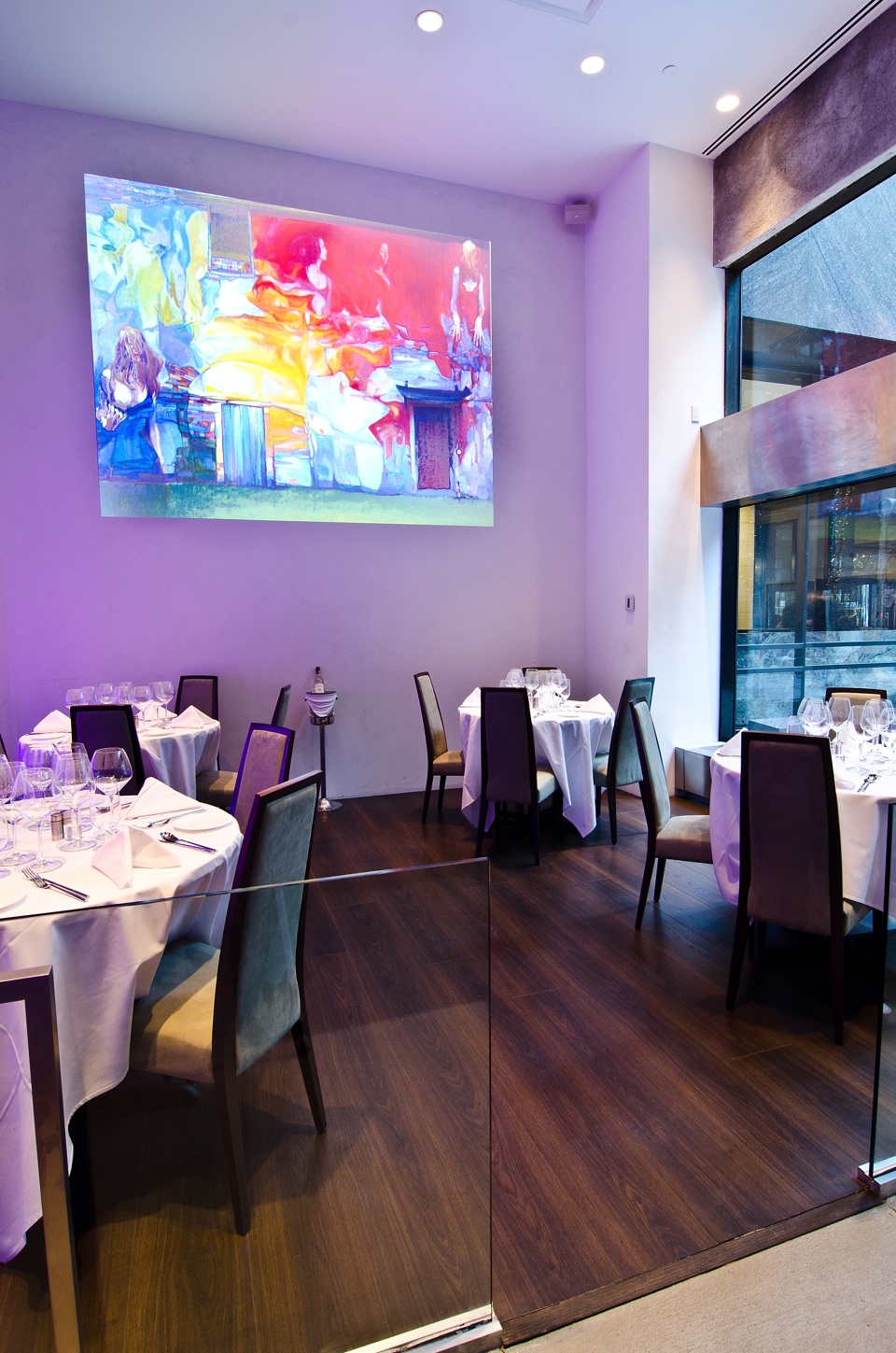 langoustine sauce, a really
lavish dish, so as a main course, its $36 price
tag may not seem so outrageous (pastas may be had in a
very generous half-portions).
langoustine sauce, a really
lavish dish, so as a main course, its $36 price
tag may not seem so outrageous (pastas may be had in a
very generous half-portions).
For fish, you'd have to have a good reason to go
beyond the fabulous Dover sole, and for meat I cannot
recommend too highly a massive dish of veal chop
stuffed with burrata
cheese over baby asparagus and prosciutto in a
translucent Madeira sauce splashed with rosemary
flakes. An equally large, pounded scaloppine of
veal is breaded, carefully sautéed and served
with a light lemon-white wine sauce.
Mr. Ghatanfard has a long history
of stocking magnificent wine cellars, and while this
midtown Valbella's is not as extensive as the
nonpareil and very beautiful cellar in Connecticut, it
is stocked with an impressive array of bottlings, not
least in Italian wines, every one at exactly 58
degrees. The prices themselves are not over the top
but the listing of so many bottles well above $100 is.
There should be far more wines under $60.
Desserts are very much in the style
of what precedes them, big, gooey, and easy to share,
like the molten chocolate cake and the cheesecake.
One NYC restaurant critic cracked
that Valbella is a kind of suburban restaurant trying
to pass in the big city. In fact, Valbella, which is
not cheap, has been long the most successful
restaurants in the Meat Packing District for years
now, serving a style of Italian-NY and continental
food that has never gone out of style. And the
packed crowd on a recent weekday night at the new
version in midtown strongly suggests that people will
be coming here in a festive mood for a very long to
come.
Valbella Midtown is open Mon.-Fri. for lunch and
dinner and on Sat. for dinner only. Appetizers run
$14-$25, pastas (full portions) $28-$36, and
main courses $30-$41.
Caviar Martinis and Sazeracs
Trump White Wine as an Aperitif
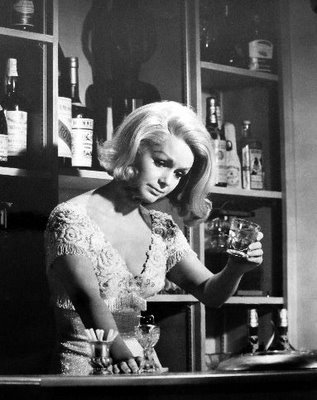 Those
old enough to remember the ‘70s will recall that the
ubiquitous offerings at every cocktail party were
onion dip, Brie and cheap white wine. Except for a
lonely bottle of vodka, booze was not much in evidence
at parties back then; indeed, the whole notion of
drinking a glass of white wine as an aperitif was one
of the defining marks of being a yuppie, along with
Ralph Lauren polo shirts and the 300-series BMW. I
also recall one conservative columnist in the ‘80s
using the phrase “cheese-eating, white wine-drinking
liberals.” Ouch!
Those
old enough to remember the ‘70s will recall that the
ubiquitous offerings at every cocktail party were
onion dip, Brie and cheap white wine. Except for a
lonely bottle of vodka, booze was not much in evidence
at parties back then; indeed, the whole notion of
drinking a glass of white wine as an aperitif was one
of the defining marks of being a yuppie, along with
Ralph Lauren polo shirts and the 300-series BMW. I
also recall one conservative columnist in the ‘80s
using the phrase “cheese-eating, white wine-drinking
liberals.” Ouch!
Those white wines got better as the years went
on, with a far greater variety of sauvignon blancs,
rieslings, malvasias and viogniers to along with
California chardonnay and Italian pinot grigio. But as
cocktail culture made a comeback in the ‘90s, with
myriad martinis, cosmos, and margaritas in fashion,
the idea of sipping a glass of wine as an aperitif now
seems almost quaint.
I have nothing against drinking a
white wine that really does stir the appetite, like a
spicy gewürztraminer, a tangy riesling, or an
aromatic moscato. The French wine aperitif Lillet is
made from white wines, but with the addition of 14
percent macerated liqueurs made from orange peel and
quinine. Champagne, of course, has the virtue of
bubbles that tingle on the tongue and throat, much as
seltzer does in a cocktail. Adding orange juice (a
mimosa) or cassis (Kir royale) improves the prospects
before dinner.
“We only have very few white wines
by the glass,” says Alexandre Petrossian, manager of Petrossian
Restaurant in New York. “The dryness of the wine
puts the palate to sleep and doesn’t go well with our
caviar. The only white wine that works well is a
Pouilly-Fumé, with a nice smoky flavor that
helps bind together the flavors. Otherwise, half our
guests order Champagne, and we serve a Caviar Martini
(below) made
with a cube of pressed caviar in a glass of very, very
cold Russian vodka with cucumber. Men first order it
and when the women taste it, they order one too.”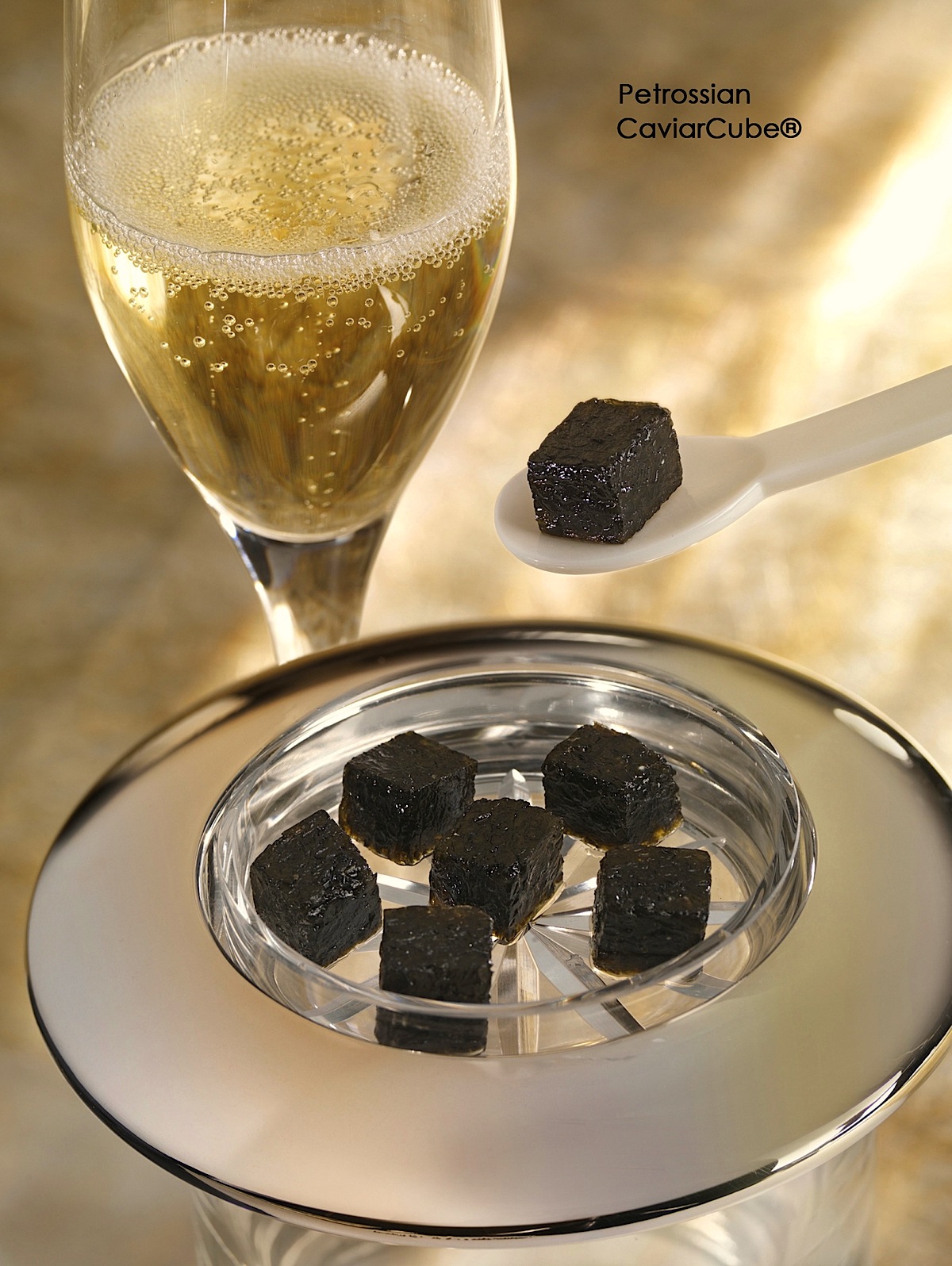
In Paris a meal is likely to begin
with Champagne, but, according to the longtime
bartender Colin Field (below) at the Hemingway
Bar at the Paris Ritz, “White
wine has often been the answer when the talents of the
bartender are apparently diminished in the cocktail
field. But due to the growing excellence of the,
already very good, American bartenders, not to mention
those French bartenders who often have done up to
three years hotel school in order to become a
bartender, it indeed would be a shame not to take
advantage of the growing talent of bartenders around
the world.” The most popular drink at the Hemingway
Bar these days is the Raspberry Martini, made with a
maceration of fresh raspberries in vodka over 3
months, then filtered and frozen and served in a
frozen Martini glass.
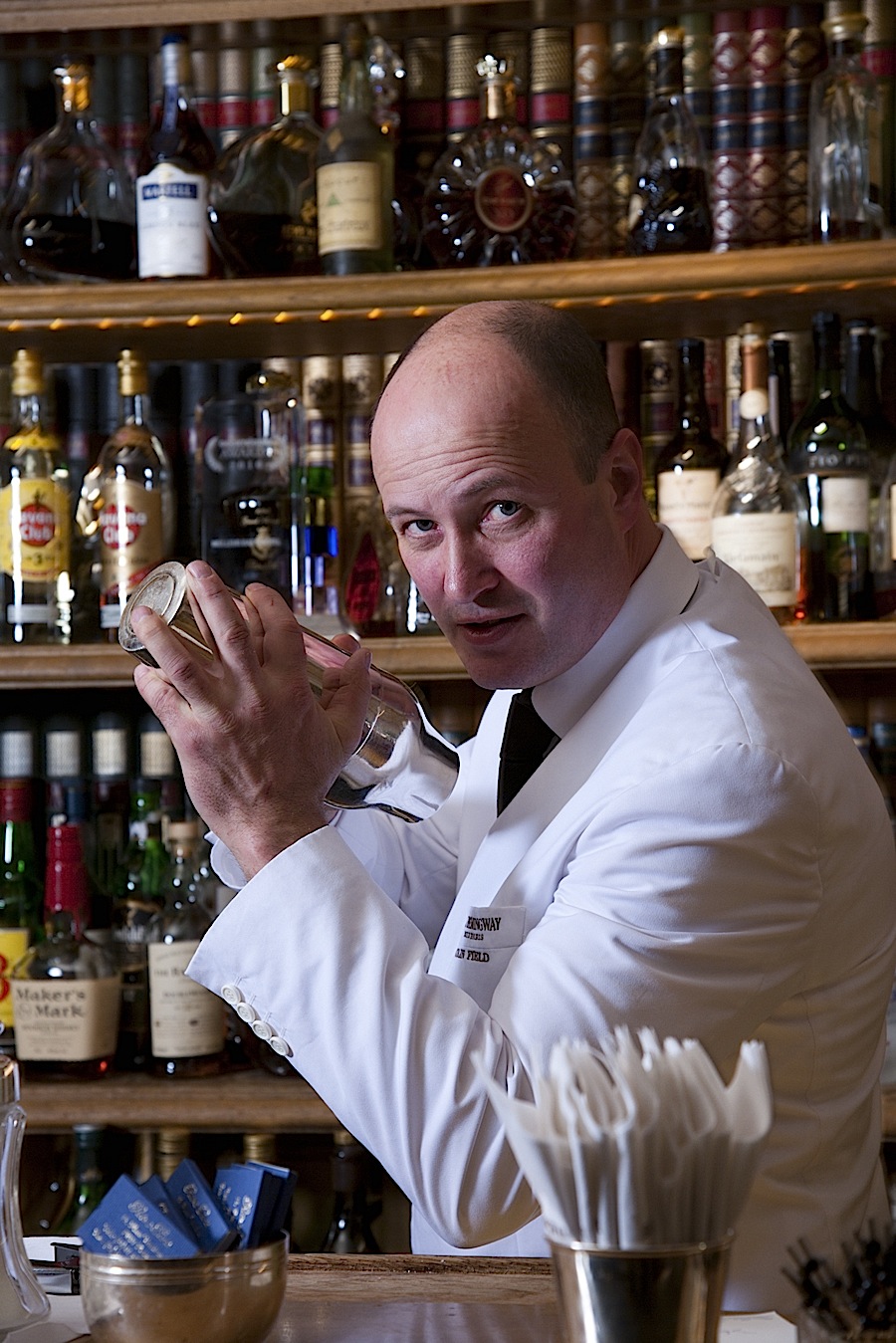 The
word “aperitif,” dating in English to 1894 (“cocktail”
appears a century earlier) is from French, meaning to
“open up,” specifically to waken the palate for the
meal to come. Wine,
white or red, can do that—and some rapid enophiles
insist that liquor dulls the palate—but they don’t
call a cocktail a pick-me-up for nothing.
The
word “aperitif,” dating in English to 1894 (“cocktail”
appears a century earlier) is from French, meaning to
“open up,” specifically to waken the palate for the
meal to come. Wine,
white or red, can do that—and some rapid enophiles
insist that liquor dulls the palate—but they don’t
call a cocktail a pick-me-up for nothing.
The idea of adding bitters to a drink was in
fact designed to spur the appetite, and bitter/sweet
liquors like vermouth, Cynar, and Campari are the
bases for drinks like the negroni and americano. “In
Italy having a cocktail is a ritual necessary to a
civilized meal,” says Pino Luongo, owner of the
two-month New York Italian restaurant Morso. “The
French and Italians invented the aperitif. A little
sweetness, a little acid, maybe some fizz from
prosecco, it is extremely pleasant to the palate and
very refreshing.”
In New Orleans, cocktail
culture has been in full swing since the early 19th
century. “New Orleans is a Southern town with a
reverence for rituals,” says Christopher Ycaza,
general manager of Galatoire’s
(opened 1905), “so jumping into dinner without a
proper cocktail here is like entering an athletic
competition without doing the proper calisthenics.”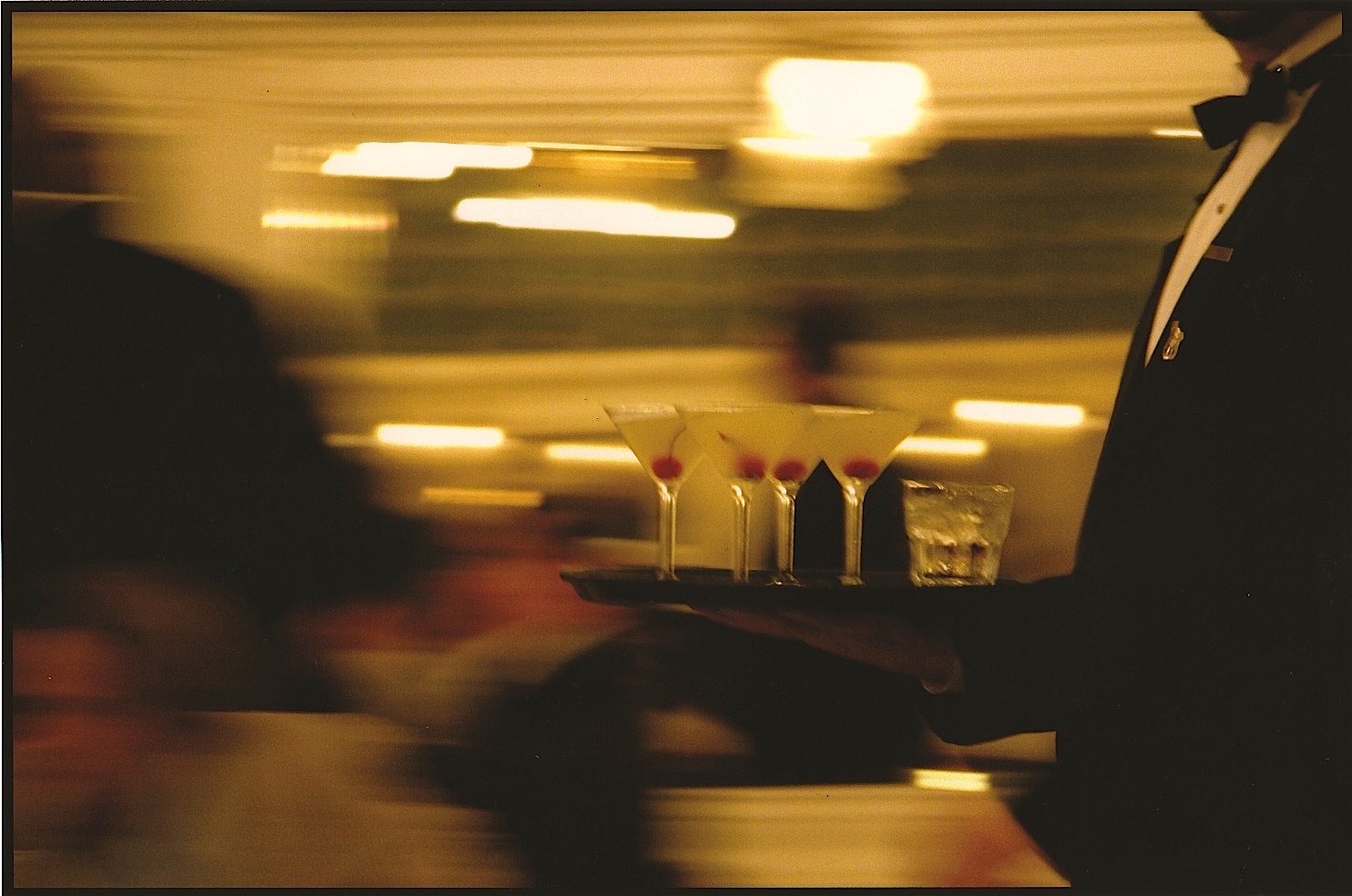 At Galatoire’s (below) the
favorite cocktail is a sazerac, for Sunday brunch, a
brandy milk punch.
At Galatoire’s (below) the
favorite cocktail is a sazerac, for Sunday brunch, a
brandy milk punch.
My own drink of choice before dinner is a
daiquiri—just rum, lime juice, and sugar—concocted
just after the Spanish-American War by Jennings S.
Cox, chief engineer of the Daiquiri iron mines in the
town of Daiquiri, outside of Santiago, Cuba. There
were plenty of limes, sugar, and Cuban rum around, so
he named the drink after the mining town. By 1920 F.
Scott Fitzgerald made it the rage drink among flappers
in his novel This
Side of Paradise.
Since so many young bartenders these days
haven’t a clue how to make one, the recipe is printed
on the back of my business card. Try putting your own
on your card. You’re pretty much guaranteed a good
aperitif.
John Mariani's wine column appears in Bloomberg Muse News, from which this story was adapted. Bloomberg News covers Culture from art, books, and theater to wine, travel, and food on a daily basis.
❖❖❖
Any of John Mariani's
books below may be ordered from amazon.com.
 |
My latest book, which just won the prize for best book from International Gourmand, written with Jim Heimann and Steven Heller, Menu Design in America, 1850-1985 (Taschen Books), has just appeared, with nearly 1,000 beautiful, historic, hilarious, sometimes shocking menus dating back to before the Civil War and going through the Gilded Age, the Jazz Age, the Depression, the nightclub era of the 1930s and 1940s, the Space Age era, and the age when menus were a form of advertising in innovative explosions of color and modern design. The book is a chronicle of changing tastes and mores and says as much about America as about its food and drink.
“Luxuriating vicariously in the pleasures of this book. . . you can’t help but become hungry. . .for the food of course, but also for something more: the bygone days of our country’s splendidly rich and complex past. Epicureans of both good food and artful design will do well to make it their coffee table’s main course.”—Chip Kidd, Wall Street Journal.
“[The menus] reflect the amazing craftsmanship that many restaurants applied to their bills of fare, and suggest that today’s restaurateurs could learn a lot from their predecessors.”—Rebecca Marx, The Village Voice. |
"Eating Italian will never be the same after reading John Mariani's entertaining and savory gastronomical history of the cuisine of Italy and how it won over appetites worldwide. . . . This book is such a tasteful narrative that it will literally make you hungry for Italian food and arouse your appetite for gastronomical history."--Don Oldenburg, USA Today. "Italian
restaurants--some good, some glitzy--far
outnumber their French rivals. Many of
these establishments are zestfully described
in How Italian Food Conquered the World, an
entertaining and fact-filled chronicle by
food-and-wine correspondent John F.
Mariani."--Aram Bakshian Jr., Wall Street
Journal.
"Equal parts
history, sociology, gastronomy, and just
plain fun, How Italian Food Conquered the
World tells the captivating and delicious
story of the (let's face it) everybody's
favorite cuisine with clarity, verve and
more than one surprise."--Colman Andrews,
editorial director of The Daily
Meal.com. "A fantastic and fascinating
read, covering everything from the influence
of Venice's spice trade to the impact of
Italian immigrants in America and the
evolution of alta cucina. This book will
serve as a terrific resource to anyone
interested in the real story of Italian
food."--Mary Ann Esposito, host of PBS-TV's
Ciao
Italia. "John Mariani has written the
definitive history of how Italians won their
way into our hearts, minds, and
stomachs. It's a story of pleasure over
pomp and taste over technique."--Danny Meyer,
owner of NYC restaurants Union Square Cafe,
Gotham Bar & Grill, The Modern, and
Maialino.
|
 |
 |
 |
 |
 |
 |
 |
 |
 Everett Potter's Travel Report:
Everett Potter's Travel Report: 
 Eating Las Vegas
is the new on-line site for Virtual Gourmet
contributor John A. Curtas., who since 1995
has been commenting on the Las Vegas food
scene and reviewing restaurants for Nevada
Public Radio. He is also the
restaurant critic for KLAS TV, Channel 8 in
Las Vegas, and his past reviews can be
accessed at KNPR.org.
Click on the logo below to go directly to
his site.
Eating Las Vegas
is the new on-line site for Virtual Gourmet
contributor John A. Curtas., who since 1995
has been commenting on the Las Vegas food
scene and reviewing restaurants for Nevada
Public Radio. He is also the
restaurant critic for KLAS TV, Channel 8 in
Las Vegas, and his past reviews can be
accessed at KNPR.org.
Click on the logo below to go directly to
his site.

Tennis Resorts Online: A Critical Guide to the World's Best Tennis Resorts and Tennis Camps, published by ROGER COX, who has spent more than two decades writing about tennis travel, including a 17-year stretch for Tennis magazine. He has also written for Arthur Frommer's Budget Travel, New York Magazine, Travel & Leisure, Esquire, Money, USTA Magazine, Men's Journal, and The Robb Report. He has authored two books-The World's Best Tennis Vacations (Stephen Greene Press/Viking Penguin, 1990) and The Best Places to Stay in the Rockies (Houghton Mifflin, 1992 & 1994), and the Melbourne (Australia) chapter to the Wall Street Journal Business Guide to Cities of the Pacific Rim (Fodor's Travel Guides, 1991).


The Family Travel Forum - A
community for those who "Have Kids, Still Travel" and
want to make family vacations more fun, less work and
better value. FTF's travel and parenting features,
including reviews of tropical and ski resorts, reunion
destinations, attractions, holiday weekends, family
festivals, cruises, and all kinds of vacation ideas
should be the first port of call for family vacation
planners. http://www.familytravelforum.com/index.html
ALL YOU NEED BEFORE YOU GO


MARIANI'S VIRTUAL GOURMET
NEWSLETTER is published weekly. Editor/Publisher: John
Mariani.
Contributing Writers: Christopher Mariani, Robert Mariani,
John A. Curtas, Edward Brivio, Mort Hochstein,
Suzanne Wright, and Brian Freedman. Contributing
Photographers: Galina Stepanoff-Dargery,
Bobby Pirillo. Technical Advisor: Gerry McLoughlin.
© copyright John Mariani 2012
 The
Hermosa Inn
The
Hermosa Inn